
Leroy Golf North Mesopotamian-Syrian Artifacts
Note that it is often difficult to tell the origin of many ancient items
for certain, especially where, as with Syria, Meospotamia and Sumeria, the
same style, materials and techinques are widely used. Our placement has been
the best guess we can make based on similarities with dated items.
G Syr-1: Tell Brak Torso
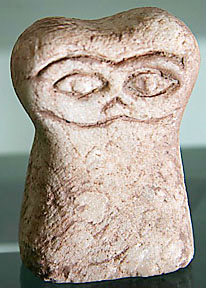 A
small, c. 60 mm limestone “occulus” statue from the Tell Brak region
of northern Irak c. 4000-3000 B.C. This distinctive form is found over the area
between the Euphrates and Tirgis during the 4th millennium and nowhere else.
Large “eye”-like images and concentric-border “occulus”
motifs are common around the neolithic and primitive world, but this remains
a unique subset. These statues are fairly common as they are found in quantities
in temples and other sacred enclosures on several sites. 73 x 51 27 mm. Location
unknown.
A
small, c. 60 mm limestone “occulus” statue from the Tell Brak region
of northern Irak c. 4000-3000 B.C. This distinctive form is found over the area
between the Euphrates and Tirgis during the 4th millennium and nowhere else.
Large “eye”-like images and concentric-border “occulus”
motifs are common around the neolithic and primitive world, but this remains
a unique subset. These statues are fairly common as they are found in quantities
in temples and other sacred enclosures on several sites. 73 x 51 27 mm. Location
unknown.
G Syr-2: Seated God Steatite Cylinder Seal
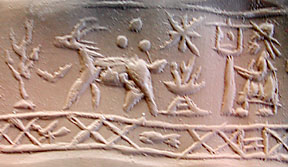 A
black steatite cylinder seal from Syria c. 1800-1600 B.C. Strongly incised and
with drilled elements. it shows the goat, associated with the storm god, stars,
crescent moon, the sacred tree, a star over a flaming altar and a seated god
or deified king with a standard. The star of divinity and altar could possibly
be a two character inscription of the owner's name rather than symbols. Around
the bottom is a double band filled with netting with birds, animals and fish
trapped in the net. This imagry seems to confirm that what is commonly called
“fishnet” pattern really is a net. The top has a single edging line,
and Syrian seals more consistently show border lines than do Mesopotamian and
Sumerian ones. This complex seal displays most of the religious symbols of Syria,
and some, like the goat, are fine engraving art. The goat was an important sacrificial
animal as a “human substitute”, and is closely linked to the storm
god Baal. Baal might even be the seated god. 33 mm x 15 mm. In a private
collection.
A
black steatite cylinder seal from Syria c. 1800-1600 B.C. Strongly incised and
with drilled elements. it shows the goat, associated with the storm god, stars,
crescent moon, the sacred tree, a star over a flaming altar and a seated god
or deified king with a standard. The star of divinity and altar could possibly
be a two character inscription of the owner's name rather than symbols. Around
the bottom is a double band filled with netting with birds, animals and fish
trapped in the net. This imagry seems to confirm that what is commonly called
“fishnet” pattern really is a net. The top has a single edging line,
and Syrian seals more consistently show border lines than do Mesopotamian and
Sumerian ones. This complex seal displays most of the religious symbols of Syria,
and some, like the goat, are fine engraving art. The goat was an important sacrificial
animal as a “human substitute”, and is closely linked to the storm
god Baal. Baal might even be the seated god. 33 mm x 15 mm. In a private
collection.
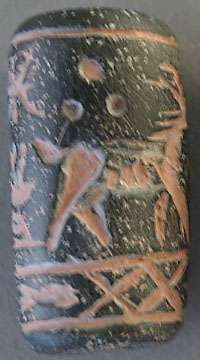
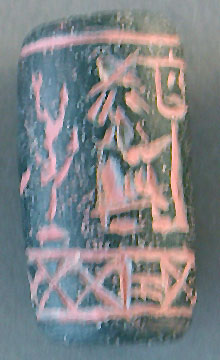
G Syr-3: Cylinder Seal with Two Birds
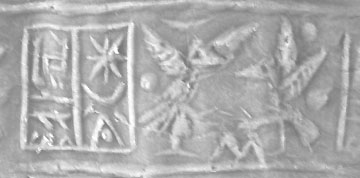 A
black steatite cylinder seal showing two birds over the sacred double mountain
of Mashu (Akkadian for “twins”). These were the sacred mountains
that Gilgamish had to pass before he could reach the land of the gods. Crescent
moon above one bird, drilled dots for stars and a boxed linear cuneiform inscription.
The second panel of the inscription seems almost more Egyptian hieroglyphic
than cuneiform, and some Syrian seals show mixed inscriptions or meaningless
‘hieroglyphs’ as symbols of fashion and power. Two birds are one
of the symbols for Ishtar and are frequently found next to her on seals. They
could also be the evil Imdugud birds since their occurrance in myth dates from
the time when Mashu figures in Sumerian mythology. 1800–1500 B.C., black
steatite, 30mm x 18 mm. In a private collection.
A
black steatite cylinder seal showing two birds over the sacred double mountain
of Mashu (Akkadian for “twins”). These were the sacred mountains
that Gilgamish had to pass before he could reach the land of the gods. Crescent
moon above one bird, drilled dots for stars and a boxed linear cuneiform inscription.
The second panel of the inscription seems almost more Egyptian hieroglyphic
than cuneiform, and some Syrian seals show mixed inscriptions or meaningless
‘hieroglyphs’ as symbols of fashion and power. Two birds are one
of the symbols for Ishtar and are frequently found next to her on seals. They
could also be the evil Imdugud birds since their occurrance in myth dates from
the time when Mashu figures in Sumerian mythology. 1800–1500 B.C., black
steatite, 30mm x 18 mm. In a private collection. 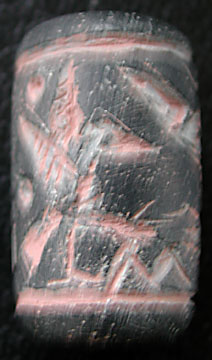
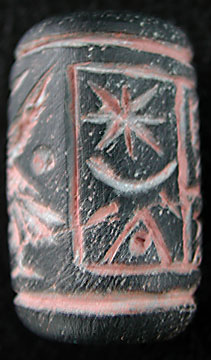
G Syr-4: Oval Domed Seal With Goat
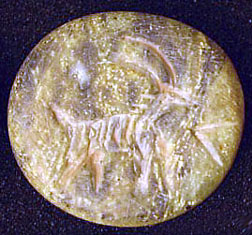 This
is a stamp seal from c. 3000-2000 B.C. of the early North Syrian cities. It
shows the Storm God's symbolic goat, drilled star and chevron. The top has a
linear, cross-hatched pattern as is found on many early seals with so-called
“linear pattern“ designs. Grey, cream and brown steatite, 35 mm
x 22 mm oval. In a private collection.
This
is a stamp seal from c. 3000-2000 B.C. of the early North Syrian cities. It
shows the Storm God's symbolic goat, drilled star and chevron. The top has a
linear, cross-hatched pattern as is found on many early seals with so-called
“linear pattern“ designs. Grey, cream and brown steatite, 35 mm
x 22 mm oval. In a private collection.
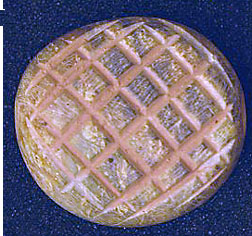
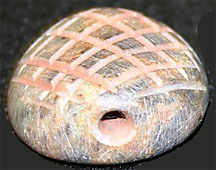
G Syr-5: Large Syrian Scaraboid
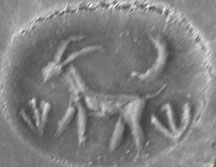 An
interesting early scaraboid. The top has engraved lines showing the scarab beetle’s
anatomy in a stylized way, a sign of very early scaraboids since later ones
have smooth tops and are much smaller. The bottom depicts a goat, two clumps
of vegetation and a crescent moon. The seal shows large areas of black discoloration
that hints at it being from a city that was sacked and burned, an altogether
too common fate of ancient cities. From c. 1000-800 B.C. Mottled grey and tan
steatite, 35 mm x 26 mm oval. In a private collection.
An
interesting early scaraboid. The top has engraved lines showing the scarab beetle’s
anatomy in a stylized way, a sign of very early scaraboids since later ones
have smooth tops and are much smaller. The bottom depicts a goat, two clumps
of vegetation and a crescent moon. The seal shows large areas of black discoloration
that hints at it being from a city that was sacked and burned, an altogether
too common fate of ancient cities. From c. 1000-800 B.C. Mottled grey and tan
steatite, 35 mm x 26 mm oval. In a private collection.
G-Syr 6: Two-Sided Amuletic Seal of Baal With Inscription
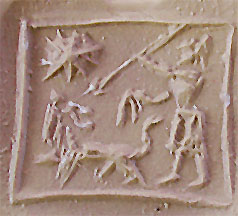
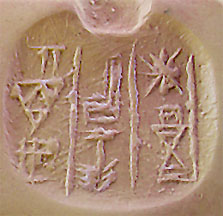 A
black stone two-sided amuletic seal. On the obverse a warrior spearing a lion
and a star of divinity in the sky -- the warrior could be Baal who had the lion
as one of his sacred animals, although the lion was also a symbol of Ishtar.
The reverse has a three-line inscription in linear cuneiform. Apx. 35 mm square
and from c. 1000-600 B.C. In a private collection.
A
black stone two-sided amuletic seal. On the obverse a warrior spearing a lion
and a star of divinity in the sky -- the warrior could be Baal who had the lion
as one of his sacred animals, although the lion was also a symbol of Ishtar.
The reverse has a three-line inscription in linear cuneiform. Apx. 35 mm square
and from c. 1000-600 B.C. In a private collection.
G-Syr 7: Rock Crystal Cylinder Seal With Naked, Winged Ishtar
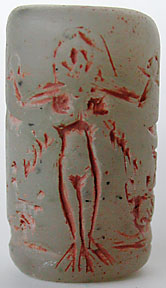
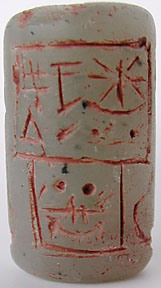 An
unclothed, winged Ishtar stands holding the rod and circle of justice in each
hand. There is a lion and crescent moon on each side, drilled stars and a table
(?). The boxed inscription is in two horizontal registers; the top a linear
cuneiform, but the bottom appears to be Egyptian hieroglyphics. Nonsense hieroglyphics
appear frequently on Syrian seals of this period as magical signs, and so these
may have no decipherable meaning. The cloudy rock crystal is a scarce material
for cylinder seals, although it could polish up to more transparent. An attractive
and unusual seal in many ways. 30 x 16 mm, c. 1000-600 B.C.
An
unclothed, winged Ishtar stands holding the rod and circle of justice in each
hand. There is a lion and crescent moon on each side, drilled stars and a table
(?). The boxed inscription is in two horizontal registers; the top a linear
cuneiform, but the bottom appears to be Egyptian hieroglyphics. Nonsense hieroglyphics
appear frequently on Syrian seals of this period as magical signs, and so these
may have no decipherable meaning. The cloudy rock crystal is a scarce material
for cylinder seals, although it could polish up to more transparent. An attractive
and unusual seal in many ways. 30 x 16 mm, c. 1000-600 B.C. 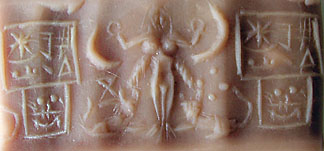
G-Syr 8: A Chalcedony Neo-Assyrian or Neo-Babylonian Stamp Seal
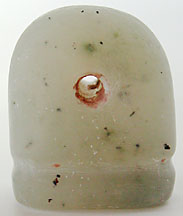
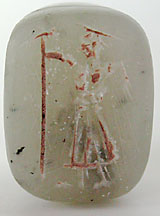 An
attractive, translucent quartz seal in the usual late first millennium style
— domed, pierced for suspension and far smaller than earlier seals. Groove
around the base and a god holding a staff on the bottom. 20 x 15 mm x 24 mm
tall, c. 800-500 B.C. In a private collection.
An
attractive, translucent quartz seal in the usual late first millennium style
— domed, pierced for suspension and far smaller than earlier seals. Groove
around the base and a god holding a staff on the bottom. 20 x 15 mm x 24 mm
tall, c. 800-500 B.C. In a private collection.
G-Syr 9: Hard Black Stone Neo-Babylonian Domed Seal
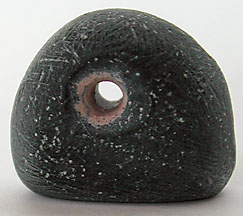
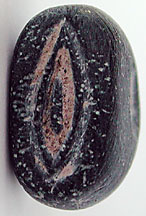 Another
Neo-Babylonian date domed stamp seal in a hard black stone, perhaps basalt.
An oval occulus motif on the bottom. This lower, small shaped seal was to become
the standard in the Parthian and Sassanian Empires up to the Arab conquest.
18 x 10 mm x 154 mm tall, c. 800-500 B.C. In a private collection.
Another
Neo-Babylonian date domed stamp seal in a hard black stone, perhaps basalt.
An oval occulus motif on the bottom. This lower, small shaped seal was to become
the standard in the Parthian and Sassanian Empires up to the Arab conquest.
18 x 10 mm x 154 mm tall, c. 800-500 B.C. In a private collection.
G-Syr 10: Pottery Statuette of Tanit
 A
hollow pottery votive statuette of the Phoenecian goddess Tanit, also a key
goddess in Carthage. Originally this would have been painted. The hands are
held in the same offeratory pose as with the ancient Sumerian stone statues.
149 mm tall, c. 900-400 B.C. Location unknown.
A
hollow pottery votive statuette of the Phoenecian goddess Tanit, also a key
goddess in Carthage. Originally this would have been painted. The hands are
held in the same offeratory pose as with the ancient Sumerian stone statues.
149 mm tall, c. 900-400 B.C. Location unknown.
G-Syr 11: An Early Bronze Age Seal From Syria Depicting an Eagle
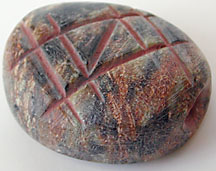
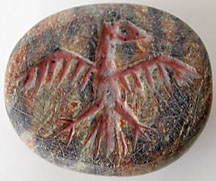 A
large stamp seal of an eagle displayed on a lightly domed steatite seal with
linear pattern top. it is drilled for suspension and shows the multi-color mottling
the Syrians so loved. The eagle is a common Syrian animal on seals and decorations,
likely a result of their environment and use of birds for hawking throughout
their history. A scarce and interesting seal. 36 x 20 mm x 12 mm high, c. 3000-2000
B.C. In a private collection.
A
large stamp seal of an eagle displayed on a lightly domed steatite seal with
linear pattern top. it is drilled for suspension and shows the multi-color mottling
the Syrians so loved. The eagle is a common Syrian animal on seals and decorations,
likely a result of their environment and use of birds for hawking throughout
their history. A scarce and interesting seal. 36 x 20 mm x 12 mm high, c. 3000-2000
B.C. In a private collection.
G-Syr 12: Gabled Early Bronze Age Marble Seal
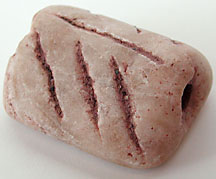
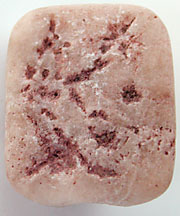 A
Syrian gabled seal of a type common through the Middle east in the fourth and
third millennia. The top has linear cuts as decoration, and the bottom a god,
star of divinity, drille dot and an object in the god’s hand. He seems
to be engaging in a ritual act. 30 x 25 mm x 14 mm high, c. 4000-2500 B.C.
A
Syrian gabled seal of a type common through the Middle east in the fourth and
third millennia. The top has linear cuts as decoration, and the bottom a god,
star of divinity, drille dot and an object in the god’s hand. He seems
to be engaging in a ritual act. 30 x 25 mm x 14 mm high, c. 4000-2500 B.C.
G-Syr 13: Bronze Age Gabled Black Stone Seal
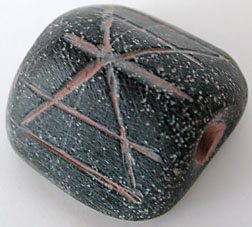
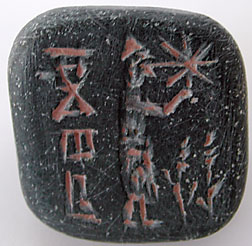 A
black hardstone stamp seal, likely basalt. It has a linear design on the top
that may relate to the Luwian hieroglyphic for “city”. The bottom
seal is a god with a star of divinity, some plants and a three character linear
cuneiform inscription, most likely a name. From the imagry I would presume this
to be a very late gable seal and date to c. 1400-800 B.C., but it is a difficult
seal to date exactly. Gable seals are mostly before 2500 B.C., the engraving
seems Old Babylonian in style, but the stone could be after 1000. x 24 mm x
14 mm high. In a private collection.
A
black hardstone stamp seal, likely basalt. It has a linear design on the top
that may relate to the Luwian hieroglyphic for “city”. The bottom
seal is a god with a star of divinity, some plants and a three character linear
cuneiform inscription, most likely a name. From the imagry I would presume this
to be a very late gable seal and date to c. 1400-800 B.C., but it is a difficult
seal to date exactly. Gable seals are mostly before 2500 B.C., the engraving
seems Old Babylonian in style, but the stone could be after 1000. x 24 mm x
14 mm high. In a private collection.
G-Syr 14: Stamp Seal With Bull and Double Mountains
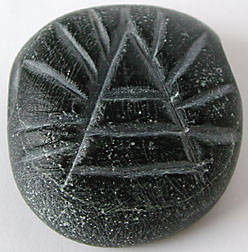
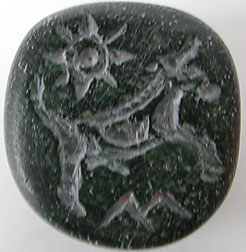 A
hard black stone (basalt?) stamp seal of irregular shape depicting a solar disk
(star of divinity?), leaping bull and double mountain. The bull is the symbol
for Baal, the thunder god and the double mountains are likely the sacred Sumerian
double mountains of Mashu that protected the land of the gods from mankind.
In Sumerian mythology only Gilgsamish, of al the mortals, was able to pass them
to the land of the gods, and he was a demigod. The top is decorated with the
Luwian hieroglyph for “city” with rays of brightness added. A noted
Luwian linguist suggested it likely is intended to mean a ‘brilliant city’,
and that the date is of the Neo-Hittite kingdoms in northern Syria. This is
a very late usage for such Anatolian hieroglyphs and shows how they continued
to be modified as symbols long after they ceased to be used for general writing.
The stone’s shape is irregular, but apx. 33 x 31 mm x 15 mm high, c. 900-600
B.C. In a private collection.
A
hard black stone (basalt?) stamp seal of irregular shape depicting a solar disk
(star of divinity?), leaping bull and double mountain. The bull is the symbol
for Baal, the thunder god and the double mountains are likely the sacred Sumerian
double mountains of Mashu that protected the land of the gods from mankind.
In Sumerian mythology only Gilgsamish, of al the mortals, was able to pass them
to the land of the gods, and he was a demigod. The top is decorated with the
Luwian hieroglyph for “city” with rays of brightness added. A noted
Luwian linguist suggested it likely is intended to mean a ‘brilliant city’,
and that the date is of the Neo-Hittite kingdoms in northern Syria. This is
a very late usage for such Anatolian hieroglyphs and shows how they continued
to be modified as symbols long after they ceased to be used for general writing.
The stone’s shape is irregular, but apx. 33 x 31 mm x 15 mm high, c. 900-600
B.C. In a private collection.
G-Syr 15: Stamp Seal of a Goat
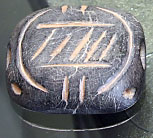
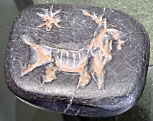 A
first millennium stamp seal of a goat and star of divinity. The goat is seen
on many seals, especially later ones, as it was a standard sacrificial animal,
sometime described as a “man equivalent”, which looks back to the
days of human sacrifice. The top is decorated with a linear design. Apx. 33
x 35 mm, c. 1800-1200 B.C. Location unknown.
A
first millennium stamp seal of a goat and star of divinity. The goat is seen
on many seals, especially later ones, as it was a standard sacrificial animal,
sometime described as a “man equivalent”, which looks back to the
days of human sacrifice. The top is decorated with a linear design. Apx. 33
x 35 mm, c. 1800-1200 B.C. Location unknown.
G-Syr 16: Amuletic Stone Stamp Seal of an Antelope
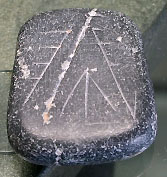
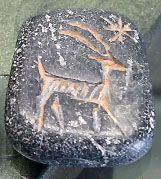 Black
stone seal with a symbolic linear design on top, possibly related to G-Syr 14
in origin, but it may also descend from a Sumerian cuneiform character. The
seal bottom shows a gazelle and a star of divinity. The animal is rather elegant
and graceful for a seal of this period. Apx. 35 x 40 mm, c. 1800-1200 B.C. Location
unknown.
Black
stone seal with a symbolic linear design on top, possibly related to G-Syr 14
in origin, but it may also descend from a Sumerian cuneiform character. The
seal bottom shows a gazelle and a star of divinity. The animal is rather elegant
and graceful for a seal of this period. Apx. 35 x 40 mm, c. 1800-1200 B.C. Location
unknown.
G-Syr 17: Neo-Babylonian Period Stamp Seal
 A chalcedony
stamp seal showing either a figure and a staff or a seated animal, transversely
pierced for suspension. Apx. 18-19 mm tall, c. 700-400 B.C. Location unknown.
A chalcedony
stamp seal showing either a figure and a staff or a seated animal, transversely
pierced for suspension. Apx. 18-19 mm tall, c. 700-400 B.C. Location unknown.
G-Syr 18: Old Babylonian Period Cylinder Seal
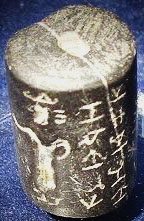
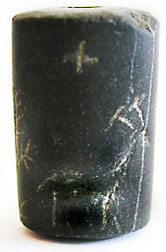 A
black stone cylinder seal with a white vein through the middle. One one half
is a god with horned hat and linear cuneiform inscription; on the other a goat,
star and sacred tree. With it’s iconically separate Babylonian and Syrian
designs it may have been the seal of a merchant who traded between the two areas.
Apx. 28 x 18 mm, c. 1900-1600 B.C. In a private collection.
A
black stone cylinder seal with a white vein through the middle. One one half
is a god with horned hat and linear cuneiform inscription; on the other a goat,
star and sacred tree. With it’s iconically separate Babylonian and Syrian
designs it may have been the seal of a merchant who traded between the two areas.
Apx. 28 x 18 mm, c. 1900-1600 B.C. In a private collection.
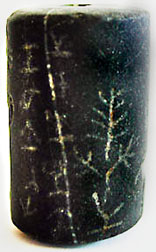
Leroy Golf Collection Home
Antiques AtoZ Home

 A
small, c. 60 mm limestone “occulus” statue from the Tell Brak region
of northern Irak c. 4000-3000 B.C. This distinctive form is found over the area
between the Euphrates and Tirgis during the 4th millennium and nowhere else.
Large “eye”-like images and concentric-border “occulus”
motifs are common around the neolithic and primitive world, but this remains
a unique subset. These statues are fairly common as they are found in quantities
in temples and other sacred enclosures on several sites. 73 x 51 27 mm. Location
unknown.
A
small, c. 60 mm limestone “occulus” statue from the Tell Brak region
of northern Irak c. 4000-3000 B.C. This distinctive form is found over the area
between the Euphrates and Tirgis during the 4th millennium and nowhere else.
Large “eye”-like images and concentric-border “occulus”
motifs are common around the neolithic and primitive world, but this remains
a unique subset. These statues are fairly common as they are found in quantities
in temples and other sacred enclosures on several sites. 73 x 51 27 mm. Location
unknown.
 A
black steatite cylinder seal from Syria c. 1800-1600 B.C. Strongly incised and
with drilled elements. it shows the goat, associated with the storm god, stars,
crescent moon, the sacred tree, a star over a flaming altar and a seated god
or deified king with a standard. The star of divinity and altar could possibly
be a two character inscription of the owner's name rather than symbols. Around
the bottom is a double band filled with netting with birds, animals and fish
trapped in the net. This imagry seems to confirm that what is commonly called
“fishnet” pattern really is a net. The top has a single edging line,
and Syrian seals more consistently show border lines than do Mesopotamian and
Sumerian ones. This complex seal displays most of the religious symbols of Syria,
and some, like the goat, are fine engraving art. The goat was an important sacrificial
animal as a “human substitute”, and is closely linked to the storm
god Baal. Baal might even be the seated god. 33 mm x 15 mm. In a private
collection.
A
black steatite cylinder seal from Syria c. 1800-1600 B.C. Strongly incised and
with drilled elements. it shows the goat, associated with the storm god, stars,
crescent moon, the sacred tree, a star over a flaming altar and a seated god
or deified king with a standard. The star of divinity and altar could possibly
be a two character inscription of the owner's name rather than symbols. Around
the bottom is a double band filled with netting with birds, animals and fish
trapped in the net. This imagry seems to confirm that what is commonly called
“fishnet” pattern really is a net. The top has a single edging line,
and Syrian seals more consistently show border lines than do Mesopotamian and
Sumerian ones. This complex seal displays most of the religious symbols of Syria,
and some, like the goat, are fine engraving art. The goat was an important sacrificial
animal as a “human substitute”, and is closely linked to the storm
god Baal. Baal might even be the seated god. 33 mm x 15 mm. In a private
collection.

 A
black steatite cylinder seal showing two birds over the sacred double mountain
of Mashu (Akkadian for “twins”). These were the sacred mountains
that Gilgamish had to pass before he could reach the land of the gods. Crescent
moon above one bird, drilled dots for stars and a boxed linear cuneiform inscription.
The second panel of the inscription seems almost more Egyptian hieroglyphic
than cuneiform, and some Syrian seals show mixed inscriptions or meaningless
‘hieroglyphs’ as symbols of fashion and power. Two birds are one
of the symbols for Ishtar and are frequently found next to her on seals. They
could also be the evil Imdugud birds since their occurrance in myth dates from
the time when Mashu figures in Sumerian mythology. 1800–1500 B.C., black
steatite, 30mm x 18 mm. In a private collection.
A
black steatite cylinder seal showing two birds over the sacred double mountain
of Mashu (Akkadian for “twins”). These were the sacred mountains
that Gilgamish had to pass before he could reach the land of the gods. Crescent
moon above one bird, drilled dots for stars and a boxed linear cuneiform inscription.
The second panel of the inscription seems almost more Egyptian hieroglyphic
than cuneiform, and some Syrian seals show mixed inscriptions or meaningless
‘hieroglyphs’ as symbols of fashion and power. Two birds are one
of the symbols for Ishtar and are frequently found next to her on seals. They
could also be the evil Imdugud birds since their occurrance in myth dates from
the time when Mashu figures in Sumerian mythology. 1800–1500 B.C., black
steatite, 30mm x 18 mm. In a private collection. 

 This
is a stamp seal from c. 3000-2000 B.C. of the early North Syrian cities. It
shows the Storm God's symbolic goat, drilled star and chevron. The top has a
linear, cross-hatched pattern as is found on many early seals with so-called
“linear pattern“ designs. Grey, cream and brown steatite, 35 mm
x 22 mm oval. In a private collection.
This
is a stamp seal from c. 3000-2000 B.C. of the early North Syrian cities. It
shows the Storm God's symbolic goat, drilled star and chevron. The top has a
linear, cross-hatched pattern as is found on many early seals with so-called
“linear pattern“ designs. Grey, cream and brown steatite, 35 mm
x 22 mm oval. In a private collection.

 An
interesting early scaraboid. The top has engraved lines showing the scarab beetle’s
anatomy in a stylized way, a sign of very early scaraboids since later ones
have smooth tops and are much smaller. The bottom depicts a goat, two clumps
of vegetation and a crescent moon. The seal shows large areas of black discoloration
that hints at it being from a city that was sacked and burned, an altogether
too common fate of ancient cities. From c. 1000-800 B.C. Mottled grey and tan
steatite, 35 mm x 26 mm oval. In a private collection.
An
interesting early scaraboid. The top has engraved lines showing the scarab beetle’s
anatomy in a stylized way, a sign of very early scaraboids since later ones
have smooth tops and are much smaller. The bottom depicts a goat, two clumps
of vegetation and a crescent moon. The seal shows large areas of black discoloration
that hints at it being from a city that was sacked and burned, an altogether
too common fate of ancient cities. From c. 1000-800 B.C. Mottled grey and tan
steatite, 35 mm x 26 mm oval. In a private collection.
 A
black stone two-sided amuletic seal. On the obverse a warrior spearing a lion
and a star of divinity in the sky -- the warrior could be Baal who had the lion
as one of his sacred animals, although the lion was also a symbol of Ishtar.
The reverse has a three-line inscription in linear cuneiform. Apx. 35 mm square
and from c. 1000-600 B.C. In a private collection.
A
black stone two-sided amuletic seal. On the obverse a warrior spearing a lion
and a star of divinity in the sky -- the warrior could be Baal who had the lion
as one of his sacred animals, although the lion was also a symbol of Ishtar.
The reverse has a three-line inscription in linear cuneiform. Apx. 35 mm square
and from c. 1000-600 B.C. In a private collection.
 An
unclothed, winged Ishtar stands holding the rod and circle of justice in each
hand. There is a lion and crescent moon on each side, drilled stars and a table
(?). The boxed inscription is in two horizontal registers; the top a linear
cuneiform, but the bottom appears to be Egyptian hieroglyphics. Nonsense hieroglyphics
appear frequently on Syrian seals of this period as magical signs, and so these
may have no decipherable meaning. The cloudy rock crystal is a scarce material
for cylinder seals, although it could polish up to more transparent. An attractive
and unusual seal in many ways. 30 x 16 mm, c. 1000-600 B.C.
An
unclothed, winged Ishtar stands holding the rod and circle of justice in each
hand. There is a lion and crescent moon on each side, drilled stars and a table
(?). The boxed inscription is in two horizontal registers; the top a linear
cuneiform, but the bottom appears to be Egyptian hieroglyphics. Nonsense hieroglyphics
appear frequently on Syrian seals of this period as magical signs, and so these
may have no decipherable meaning. The cloudy rock crystal is a scarce material
for cylinder seals, although it could polish up to more transparent. An attractive
and unusual seal in many ways. 30 x 16 mm, c. 1000-600 B.C. 

 An
attractive, translucent quartz seal in the usual late first millennium style
— domed, pierced for suspension and far smaller than earlier seals. Groove
around the base and a god holding a staff on the bottom. 20 x 15 mm x 24 mm
tall, c. 800-500 B.C. In a private collection.
An
attractive, translucent quartz seal in the usual late first millennium style
— domed, pierced for suspension and far smaller than earlier seals. Groove
around the base and a god holding a staff on the bottom. 20 x 15 mm x 24 mm
tall, c. 800-500 B.C. In a private collection.
 Another
Neo-Babylonian date domed stamp seal in a hard black stone, perhaps basalt.
An oval occulus motif on the bottom. This lower, small shaped seal was to become
the standard in the Parthian and Sassanian Empires up to the Arab conquest.
18 x 10 mm x 154 mm tall, c. 800-500 B.C. In a private collection.
Another
Neo-Babylonian date domed stamp seal in a hard black stone, perhaps basalt.
An oval occulus motif on the bottom. This lower, small shaped seal was to become
the standard in the Parthian and Sassanian Empires up to the Arab conquest.
18 x 10 mm x 154 mm tall, c. 800-500 B.C. In a private collection. A
hollow pottery votive statuette of the Phoenecian goddess Tanit, also a key
goddess in Carthage. Originally this would have been painted. The hands are
held in the same offeratory pose as with the ancient Sumerian stone statues.
149 mm tall, c. 900-400 B.C. Location unknown.
A
hollow pottery votive statuette of the Phoenecian goddess Tanit, also a key
goddess in Carthage. Originally this would have been painted. The hands are
held in the same offeratory pose as with the ancient Sumerian stone statues.
149 mm tall, c. 900-400 B.C. Location unknown.
 A
large stamp seal of an eagle displayed on a lightly domed steatite seal with
linear pattern top. it is drilled for suspension and shows the multi-color mottling
the Syrians so loved. The eagle is a common Syrian animal on seals and decorations,
likely a result of their environment and use of birds for hawking throughout
their history. A scarce and interesting seal. 36 x 20 mm x 12 mm high, c. 3000-2000
B.C. In a private collection.
A
large stamp seal of an eagle displayed on a lightly domed steatite seal with
linear pattern top. it is drilled for suspension and shows the multi-color mottling
the Syrians so loved. The eagle is a common Syrian animal on seals and decorations,
likely a result of their environment and use of birds for hawking throughout
their history. A scarce and interesting seal. 36 x 20 mm x 12 mm high, c. 3000-2000
B.C. In a private collection.
 A
Syrian gabled seal of a type common through the Middle east in the fourth and
third millennia. The top has linear cuts as decoration, and the bottom a god,
star of divinity, drille dot and an object in the god’s hand. He seems
to be engaging in a ritual act. 30 x 25 mm x 14 mm high, c. 4000-2500 B.C.
A
Syrian gabled seal of a type common through the Middle east in the fourth and
third millennia. The top has linear cuts as decoration, and the bottom a god,
star of divinity, drille dot and an object in the god’s hand. He seems
to be engaging in a ritual act. 30 x 25 mm x 14 mm high, c. 4000-2500 B.C.
 A
black hardstone stamp seal, likely basalt. It has a linear design on the top
that may relate to the Luwian hieroglyphic for “city”. The bottom
seal is a god with a star of divinity, some plants and a three character linear
cuneiform inscription, most likely a name. From the imagry I would presume this
to be a very late gable seal and date to c. 1400-800 B.C., but it is a difficult
seal to date exactly. Gable seals are mostly before 2500 B.C., the engraving
seems Old Babylonian in style, but the stone could be after 1000. x 24 mm x
14 mm high. In a private collection.
A
black hardstone stamp seal, likely basalt. It has a linear design on the top
that may relate to the Luwian hieroglyphic for “city”. The bottom
seal is a god with a star of divinity, some plants and a three character linear
cuneiform inscription, most likely a name. From the imagry I would presume this
to be a very late gable seal and date to c. 1400-800 B.C., but it is a difficult
seal to date exactly. Gable seals are mostly before 2500 B.C., the engraving
seems Old Babylonian in style, but the stone could be after 1000. x 24 mm x
14 mm high. In a private collection.
 A
hard black stone (basalt?) stamp seal of irregular shape depicting a solar disk
(star of divinity?), leaping bull and double mountain. The bull is the symbol
for Baal, the thunder god and the double mountains are likely the sacred Sumerian
double mountains of Mashu that protected the land of the gods from mankind.
In Sumerian mythology only Gilgsamish, of al the mortals, was able to pass them
to the land of the gods, and he was a demigod. The top is decorated with the
Luwian hieroglyph for “city” with rays of brightness added. A noted
Luwian linguist suggested it likely is intended to mean a ‘brilliant city’,
and that the date is of the Neo-Hittite kingdoms in northern Syria. This is
a very late usage for such Anatolian hieroglyphs and shows how they continued
to be modified as symbols long after they ceased to be used for general writing.
The stone’s shape is irregular, but apx. 33 x 31 mm x 15 mm high, c. 900-600
B.C. In a private collection.
A
hard black stone (basalt?) stamp seal of irregular shape depicting a solar disk
(star of divinity?), leaping bull and double mountain. The bull is the symbol
for Baal, the thunder god and the double mountains are likely the sacred Sumerian
double mountains of Mashu that protected the land of the gods from mankind.
In Sumerian mythology only Gilgsamish, of al the mortals, was able to pass them
to the land of the gods, and he was a demigod. The top is decorated with the
Luwian hieroglyph for “city” with rays of brightness added. A noted
Luwian linguist suggested it likely is intended to mean a ‘brilliant city’,
and that the date is of the Neo-Hittite kingdoms in northern Syria. This is
a very late usage for such Anatolian hieroglyphs and shows how they continued
to be modified as symbols long after they ceased to be used for general writing.
The stone’s shape is irregular, but apx. 33 x 31 mm x 15 mm high, c. 900-600
B.C. In a private collection.
 A
first millennium stamp seal of a goat and star of divinity. The goat is seen
on many seals, especially later ones, as it was a standard sacrificial animal,
sometime described as a “man equivalent”, which looks back to the
days of human sacrifice. The top is decorated with a linear design. Apx. 33
x 35 mm, c. 1800-1200 B.C. Location unknown.
A
first millennium stamp seal of a goat and star of divinity. The goat is seen
on many seals, especially later ones, as it was a standard sacrificial animal,
sometime described as a “man equivalent”, which looks back to the
days of human sacrifice. The top is decorated with a linear design. Apx. 33
x 35 mm, c. 1800-1200 B.C. Location unknown.
 Black
stone seal with a symbolic linear design on top, possibly related to G-Syr 14
in origin, but it may also descend from a Sumerian cuneiform character. The
seal bottom shows a gazelle and a star of divinity. The animal is rather elegant
and graceful for a seal of this period. Apx. 35 x 40 mm, c. 1800-1200 B.C. Location
unknown.
Black
stone seal with a symbolic linear design on top, possibly related to G-Syr 14
in origin, but it may also descend from a Sumerian cuneiform character. The
seal bottom shows a gazelle and a star of divinity. The animal is rather elegant
and graceful for a seal of this period. Apx. 35 x 40 mm, c. 1800-1200 B.C. Location
unknown. A chalcedony
stamp seal showing either a figure and a staff or a seated animal, transversely
pierced for suspension. Apx. 18-19 mm tall, c. 700-400 B.C. Location unknown.
A chalcedony
stamp seal showing either a figure and a staff or a seated animal, transversely
pierced for suspension. Apx. 18-19 mm tall, c. 700-400 B.C. Location unknown.
 A
black stone cylinder seal with a white vein through the middle. One one half
is a god with horned hat and linear cuneiform inscription; on the other a goat,
star and sacred tree. With it’s iconically separate Babylonian and Syrian
designs it may have been the seal of a merchant who traded between the two areas.
Apx. 28 x 18 mm, c. 1900-1600 B.C. In a private collection.
A
black stone cylinder seal with a white vein through the middle. One one half
is a god with horned hat and linear cuneiform inscription; on the other a goat,
star and sacred tree. With it’s iconically separate Babylonian and Syrian
designs it may have been the seal of a merchant who traded between the two areas.
Apx. 28 x 18 mm, c. 1900-1600 B.C. In a private collection.
